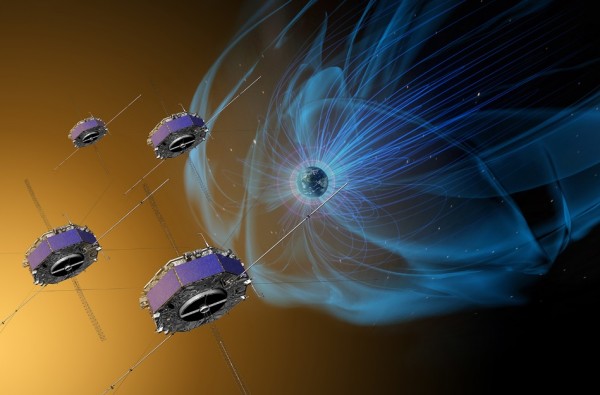For the First Time, NASA Satellites Observe Magnetic Explosions in Space Weather
| Ana Verayo | | May 15, 2016 08:49 AM EDT |
(Photo : NASA/Goddard/Conceptual Image Lab) The four Magnetospheric Multiscale, or MMS, spacecraft (shown here in an artist's concept) have now made more than 4,000 trips through the boundaries of Earth's magnetic field, gathering observations of our dynamic space environment.
Space weather also includes magnetic explosions as NASA satellites were able to detect these new cosmic activities above the surface of Earth, by observing the magnetic field of the planet and common space weather events as well.
Like Us on Facebook
This new discovery can help astronomers to predict space weather with more accuracy as magnetic storms triggered by solar activity can produce destructive impact on Earth such as disrupting telecommunications due to magnetic reconnection, disturbing the planet's network of satellites.
The planet is protected by this magnetic layer in the atmosphere known as the magnetosphere that serves as a shield from dangerous radiation from space. A magnetic reconnection occurs when the Earth's magnetic field and the sun's magnetic field or any magnetic field across space, interacts with each other from different wavelengths.
When these fields run into each other and clash, they get disrupted and scramble back into reconnection resulting in these magnetic explosions. On a micro level, this explosive magnetic reconnection is filled with protons and electrons shooting out in every direction.
Scientists have already observed this interaction before however in this new study, this is the first time that astronomers were able to obtain measurements of these electrons. During observations, electrons were seen shooting in straight lines from its original source beginning at hundreds of miles for every second, in otherwise restricted field boundaries.
When the electrons reach the end of these straight trajectories, they bounce back as a new magnetic connection in the magnetic field.According to author of the study, Jonathan Eastwood of the Imperial College London, there were past theories about electron movement in magnetic reconnection however, this is the first direct evidence of this activity.
NASA's Magnetospheric Multiscale Mission (MMS), began in March 2015 where observations were obtained between that time until October 2015, when electrons finally achieved a magnetic reconnection when the planet's magnetic field lines were disrupted and clashed with the sun's magnetosphere. Using simulations known as the crescent model, results confirmed that electrons travel a certain distance before it bounces back again.
This new study is published in the journal, Science.
TagsMagnetic Field, magnetic explosions, space weather, NASA, Magnetosphere, NASA MMS, magnetic reconnection
©2015 Chinatopix All rights reserved. Do not reproduce without permission
EDITOR'S PICKS
-

Did the Trump administration just announce plans for a trade war with ‘hostile’ China and Russia?
-

US Senate passes Taiwan travel bill slammed by China
-

As Yan Sihong’s family grieves, here are other Chinese students who went missing abroad. Some have never been found
-

Beijing blasts Western critics who ‘smear China’ with the term sharp power
-

China Envoy Seeks to Defuse Tensions With U.S. as a Trade War Brews
-

Singapore's Deputy PM Provides Bitcoin Vote of Confidence Amid China's Blanket Bans
-

China warns investors over risks in overseas virtual currency trading
-

Chinese government most trustworthy: survey
-

Kashima Antlers On Course For Back-To-Back Titles
MOST POPULAR
LATEST NEWS
Zhou Yongkang: China's Former Security Chief Sentenced to Life in Prison

China's former Chief of the Ministry of Public Security, Zhou Yongkang, has been given a life sentence after he was found guilty of abusing his office, bribery and deliberately ... Full Article
TRENDING STORY

China Pork Prices Expected to Stabilize As The Supplies Recover

Elephone P9000 Smartphone is now on Sale on Amazon India

There's a Big Chance Cliffhangers Won't Still Be Resolved When Grey's Anatomy Season 13 Returns

Supreme Court Ruled on Samsung vs Apple Dispute for Patent Infringement

Microsoft Surface Pro 5 Rumors and Release Date: What is the Latest?










